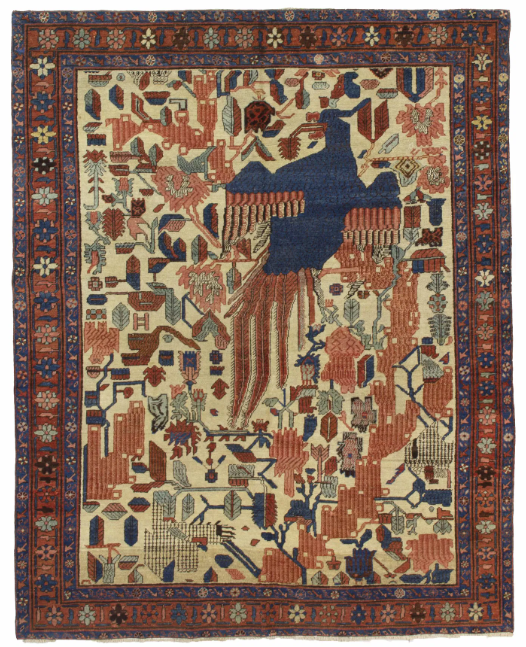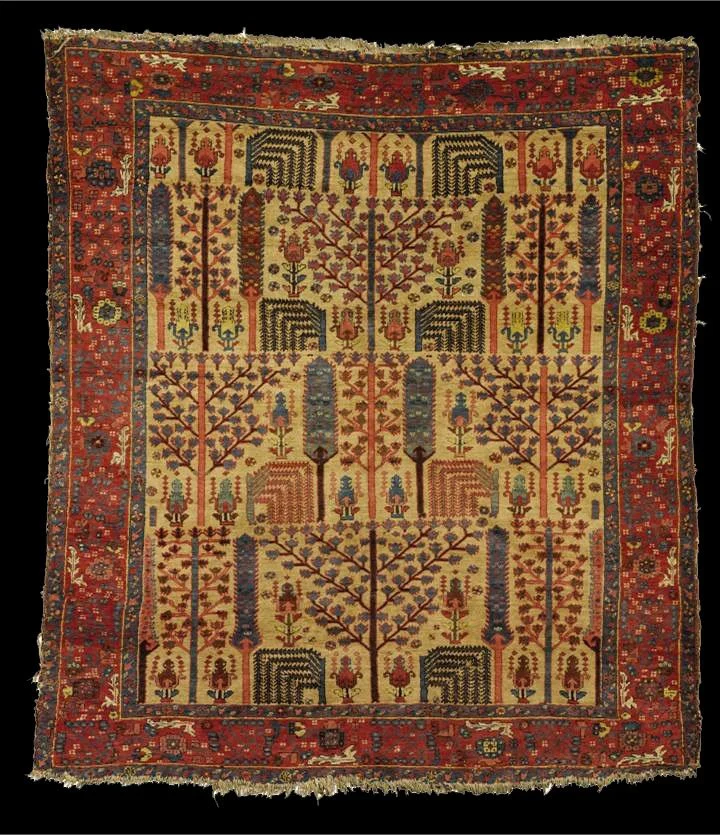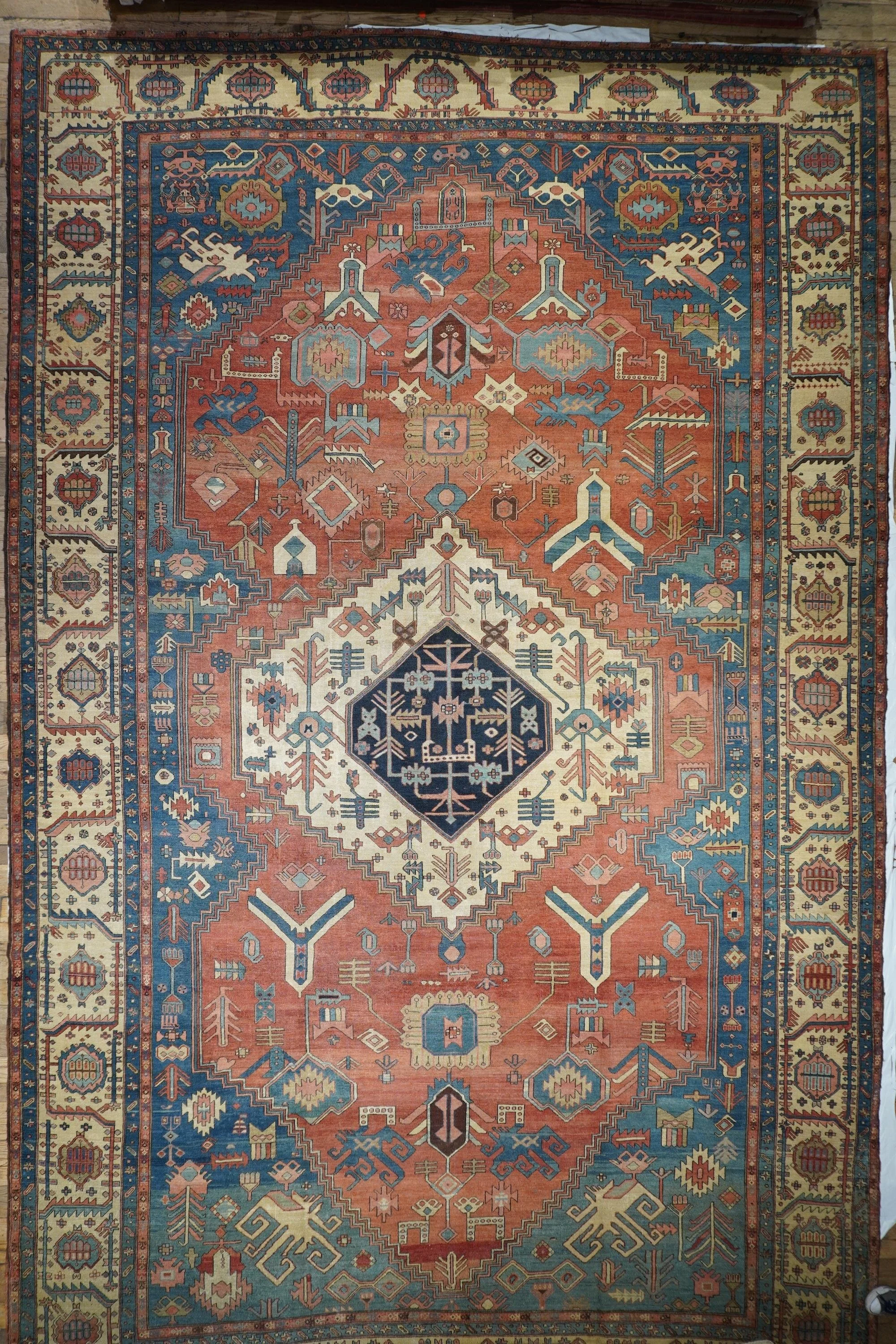Bakshayesh
Origins: Bakshayesh carpets originate from the Bakshayesh region, situated near the town of Heriz in northwestern Iran. Known for its deep-rooted tradition in rug weaving, Bakshayesh has been a significant contributor to Persian carpet artistry for centuries. These carpets are highly regarded for their robust construction and unique designs.
Design: Bakshayesh carpets are renowned for their striking, bold designs. They typically feature large, central medallions surrounded by geometric patterns and intricate floral motifs. The designs often incorporate a vibrant color palette, including rich reds, deep blues, warm earth tones, and contrasting highlights like ivory and gold.
Construction: Crafted by hand, Bakshayesh carpets use high-quality wool, known for its durability and rich texture. The wool is carefully spun and dyed to enhance the carpet’s visual appeal and resilience. These carpets are hand-knotted using traditional Persian techniques, resulting in a sturdy and long-lasting pile.
Size and Shape: Bakshayesh carpets come in various sizes to suit different spaces, from small accent rugs to large area rugs. They are commonly available in rectangular and square shapes, though custom sizes and shapes can be created to meet specific design requirements.
Quality and Collectability: Bakshayesh carpets are prized for their exceptional quality and distinctive designs. They are highly valued by collectors and interior designers for their craftsmanship and aesthetic appeal. Due to their robust construction and unique artistic elements, Bakshayesh carpets are considered valuable investments.
Cultural Significance: Bakshayesh carpets reflect a rich tradition of Persian weaving, representing the artistic and cultural heritage of the Bakshayesh region. They embody the craftsmanship and artistic expression that have been handed down through generations, showcasing the region’s historical and cultural depth.
Evolution: Over time, Bakshayesh carpets have evolved to incorporate both traditional and contemporary design elements. While maintaining their classic bold patterns and colors, modern Bakshayesh carpets often feature updated hues and reinterpretations of traditional motifs, appealing to a wide range of tastes and styles.
Antique Phoniex bakshaish carpet that is best of type
Antique Phoniex and dragon bakshaish carpet, a staple of seasoned collectors
History
Bakshaish carpets, originating from the village of Bakshaish in northwestern Iran, boast a rich history that quite possibly dates back to the 11th century during the Seljuk period. Scholars suggest that the Seljuks introduced the symmetrical (Turkish) knot to the region, laying the groundwork for the weaving techniques that would define Persian rug artistry. Located near Tabriz, Bakshaish became one of the most influential weaving centers in Persian Azerbaijan, blending the aesthetic freedom of village weavers with echoes of classical court designs.
A weeping willow design that is stunning replete with camel hair field
These carpets are admired for their abstract, large-scale motifs that reinterpret traditional Persian forms through a rustic, expressive lens. Characteristic features include oversized medallions, stylized floral patterns, and a bold use of space and color. The weavers often employed natural vegetable dyes, yielding rich earth tones and jewel-like blues and reds that age beautifully over time. Bakshaish rugs are considered some of the finest examples of village weaving, maintaining a balance between spontaneity and design coherence.
Second Revival
During the 19th century, especially in the Second Golden Age of Persian weaving (circa 1800–1910), Bakshaish carpets reached a pinnacle of artistic excellence. The village’s weavers often broke from rigid templates to create singular works of textile art, expressing their own creativity within traditional frameworks. These pieces—typically room-sized with inventive layouts—are now treasured by museums, collectors, and designers for their originality and enduring beauty. Institutions like the Claremont Rug Company have helped elevate their status, preserving their legacy and sharing their stories with modern audiences.
A Gorgeous camel field all over bakshayesh carpet
Many Bakshaish carpets feature distinct iconography such as the Phoenix and Dragon, Weeping Willow, Tree of Life, and angular animal figures—motifs that connect them to ancient Persian mythology and symbolism. These narrative elements, rendered with geometric flair, give the rugs both visual and cultural depth. Their uniqueness and artistry attracted elite collectors; for example, members of the Rothschild family and other European aristocrats were known to acquire Bakshaish carpets for their estates, recognizing their historical value and aesthetic rarity.
A beautiful bakshaish carpet with vivid natural dyes, the abstract design is stunning





